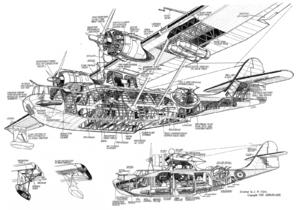| PBY Catalina | |
|---|---|
| File:Consolidated PBV-1A Catalina '433915' Miss Pick Up (G-PBYA).jpg | |
| A restored OA-10 Catalina in US Army Air Corps colors | |
| Role | Maritime patrol bomber, search and rescue seaplane |
| National origin | United States |
| Manufacturer | Consolidated Aircraft |
| Built by | Boeing Canada (PB2B) Canadian Vickers (PBV) Naval Aircraft Factory (PBN) Soviet Gidrosamolet Transportnii factory at Taganrog (GST) |
| First flight | 21 March 1935 |
| Introduction | October 1936, United States Navy |
| Retired | January 1957 (United States Navy Reserve) 1982 (Brazilian Air Force) |
| Primary users | United States Navy United States Army Air Forces Royal Air Force Royal Canadian Air Force |
| Produced | 1936–1945 |
| Number built | 3,308 (2,661 U.S.-built,[1] 620 Canadian-built, 27 Soviet-built)[2] |
| Variants | Bird Innovator |
The Consolidated Model 28, more commonly known as the PBY Catalina (US Navy designation), is a flying boat and amphibious aircraft that was produced in the 1930s and 1940s. In Canadian service it was known as the Canso. It was one of the most widely used seaplanes of World War II. Catalinas served with every branch of the United States Armed Forces and in the air forces and navies of many other nations. The last military PBYs served until the 1980s. As of 2021, 86 years after its first flight, the aircraft continues to fly as a waterbomber (or airtanker) in aerial firefighting operations in some parts of the world. No Catalinas remain in military service.
